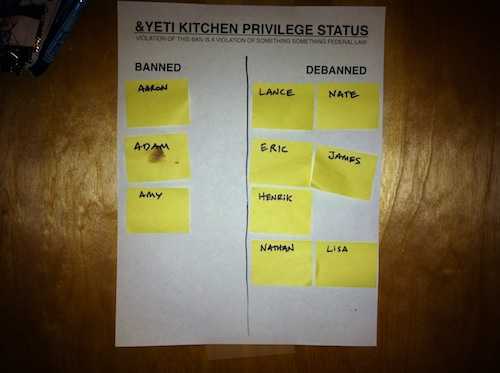At &yet, we're always fighting to get ourselves to log hours. We recently came up with a method inspired by Fitt's Law that's proven quite effective.
Fitt's Law, as it applies to interface design, essentially says the smaller and further away a target is, the harder it is to hit.
That's why we get Apple positioning the OS X menu at the very top of our workspace and the Dock at the bottom. The edge of the screen can be said to have infinite width in the direction the mouse hits it, making it an easy target.
What we've realized is that Fitt's Law can apply in physical space, too. Take time tracking, for example.
We all want to track our time, but nothing we've tried has worked. Lots of methods and tools help some people, but there are few things that help everyone. Nagging and reminders are worthlessly ineffective when it comes to changing behavior. Tools are hit or miss.
We've tried lots of things, but this one was 100% successful: over several weeks' time, the longest any person went without logging their hours was a day and a half—and most logged them daily. That has never happened in three years of trying to solve this.
Here's how we "Fittsed" time-tracking.
Logging time effectively is a very hard thing. Doing it consistently means a whole lot of tiny actions and a ton of reminders, each individual piece fairly meaningless. To further complicate matters, it's something that highly productive people naturally want to "background", not stick in their face while getting stuff done. That means by design, it's going to be easy to forget.
What if we could associate logging time with the "edge" of our workspace in real life, not the workspace itself?
Our kitchen is central to our office in almost every way. We keep it stocked daily with whatever snacks and drinks each member of our team wants to have available. The coffee's there and lots of great conversations get started in the kitchen, too. Everyone uses it every day, all day—typically at stopping points in their work.
I know from experience it won't work to just stick a reminder on my monitor or where I'll see it as I walk away from my desk. Unlike those, the kitchen is a destination. It's a hard "edge" in the office interface.
So now we use it as a privilege, not a right. There is a piece of paper taped to the door with a line down the middle and everyone's names on tiny Post-It Notes. On one side is the word "BANNED" and on the other, "DEBANNED".
If I haven't logged my hours within the past 24 hours, my name gets moved from the "DEBANNED" to the "BANNED" list (by Lisa, our office manager). All I have to do to get it moved back is go to my office and spend a moment logging hours.
The centrality of the kitchen means it's easily enforced by peer pressure and the additional office fun of public "shaming".
It's helped along by another edge: the hallway and the kitchen are also the edge of my personal bubble. When we're out in the hall, we rib each other and tease each other and push each other to succeed on whatever we're working on together. That edge reminds me not just of the edge of my workspace, but the edge of where "I" end and "we" begin. Not a bad place to be reminded of the intrinsic value of logging hours.
It's surprised us how well this has worked. In fact, un-banned people walking into the kitchen mid-day have gone back to log their recent hours because of the physical space reminder.
For some time, we have been thinking constantly about ways to improve the user experience of accomplishing big things as a team with minimal intrusion and maximum benefit. Most of the learning we've done in this area we've been pouring into a product we've been building called &! ("and bang"). You can get on the invite list here.
--
Many thanks to Nate for his critical feedback on this post, without which it might have been even more abstract and made less sense. :) But, hey, you know what they say...
